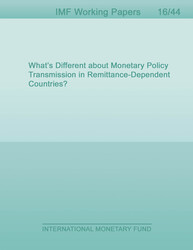
What’s Different about Monetary Policy Transmission in Remittance-Dependent Countries?
Despite welfare and poverty-reducing benefits for recipient households, remittance inflows have been shown to entail macroeconomic challenges; producing Dutch Disease-type effects through their upward (appreciation) pressure on real exchange rates, reducing the quality of institutions, delaying fiscal adjustment, and ultimately having an indeterminate effect on long-run growth. The paper explores an additional challenge, for monetary policy. Although they expand bank balance sheets, providing a stable flow of interest-insensitive funding, remittances tend to increase banks’ holdings of liquid assets. This both reduces the need for an interbank market and severs the link between the policy rate and banks’ marginal costs of funds, thus shutting down a major transmission channel. We develop a stylized model based on asymmetric information and a lack of transparent borrowers and undertake econometric analysis providing evidence that increased remittance inflows are associated with a weaker transmission. As independent monetary policy becomes impaired, this result is consistent with earlier findings that recipient countries tend to favor fixed exchange rate regimes.
Publication date: March 2016
ISBN: 9781513531236
$18.00
Add to Cart by clicking price of the language and format you'd like to purchase
Available Languages and Formats
| English |
Prices in red indicate formats that are not yet available but are forthcoming.
Topics covered in this book
This title contains information about the following subjects.
Click on a subject if you would like to see other titles with the same subjects.
Economics- Macroeconomics , Economics / General , International - Economics , Worker’ , s Remittances , Monetary Policy , lending channel , banking sector
Summary
Copyright © 2010 - 2024
Powered by:
AIDC



